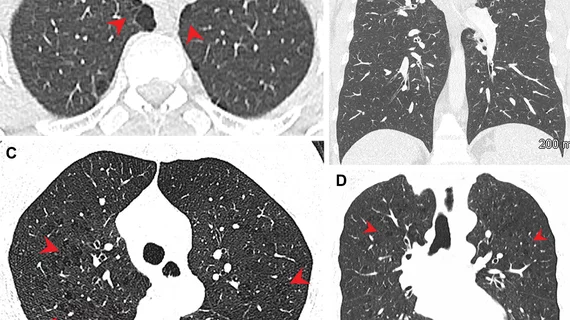Why do chest CT findings differ between marijuana and tobacco-only smokers?
As marijuana use continues to grow around the world, it is important to understand if health implications, particularly within the lungs, pose risks to those who consume it.
A new study published in Radiology looked into the potential impact marijuana use has on the lungs by analyzing and comparing the chest imaging of marijuana smokers to nonsmokers and those who smoke tobacco only. On imaging, experts observed several imaging manifestations in marijuana smokers, including increases in airway inflammation and emphysema, compared to the other two groups.
Corresponding author of the paper, Luke Murtha, from the Department of Radiology at Ottawa Hospital General Campus in Canada, and colleagues noted that several prior studies have examined the effects of marijuana use on the lungs by way of pulmonary function tests, but that only two other studies utilized chest imaging. Unfortunately, those studies were unable to draw clear conclusions on the associations between respiratory ailments and smoking marijuana.
For this study, researchers analyzed CT chest exams from three separate groups—marijuana smokers (56), tobacco-only smokers (33) and nonsmokers (57). Higher rates of emphysema (paraseptal emphysema, in particular) were seen in marijuana smokers in comparison to nonsmokers and in age-matched tobacco-only smokers. Gynecomastia, bronchial thickening, bronchiectasis and mucoid impaction were also higher in marijuana smokers than in the other groups.
The researchers noted that these changes could potentially be attributed to the way in which marijuana is consumed in comparison to tobacco cigarettes, noting that smoking marijuana typically involves a “full inhalation with a sustained Valsalva maneuver,” which could “lead to microbarotrauma and peripheral airspace changes, such as apical bullae.”
This could explain why paraseptal emphysema was the dominant pattern observed in marijuana smokers, while centrilobular emphysema was most common among tobacco-only smokers.
“This may represent an earlier stage of apical bulla formation reported in marijuana smokers and may explain the absence of the typical pulmonary function test changes of chronic obstructive pulmonary disease in marijuana smokers,” the authors explained.
The authors acknowledged the small sample size as a limitation of their research but encouraged the continued study of the impact of marijuana use, as its legalization continues to grow.
The study abstract can be viewed here.

